CENTENARY: The women who died for Ireland
Published in Features, Issue 5 (September/October 2018), Revolutionary Period 1912-23, Volume 26Cumann na mBan fatalities in the War of Independence and Civil War.
By Pádraig Óg Ó Ruairc
This year marks several important milestones in the history of women’s struggle in Ireland. The centenaries of the extension of the vote to women and the election of Constance Markievicz as the first female MP will be widely celebrated. Less well known is that this year also marks the centenary of the death of Josephine McGowan, the first of several Cumann na mBan fatalities during the Irish Revolution. Although the central role that women played in the republican struggle from 1916 to 1923 is now widely known, the fact that a number of women died for that cause has been almost completely forgotten.
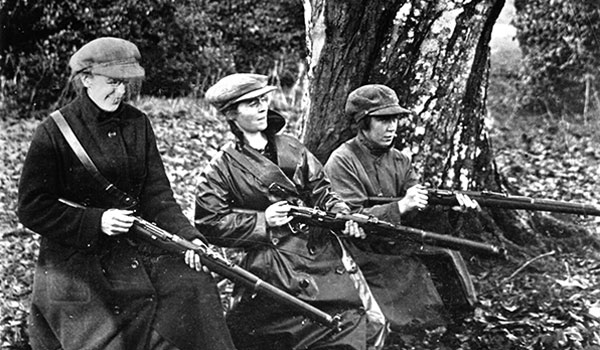
Above: Cumann na mBan members Linda Kearns, Eithne Coyle and Mae Burke pose with rifles at an IRA training camp at Ducket’s Grove, Co. Carlow, in October 1921. (Mercier Press)
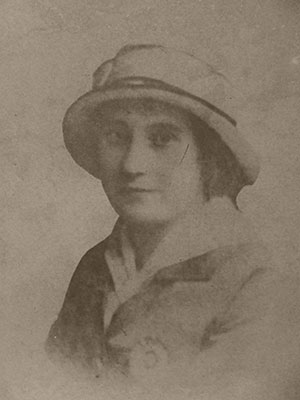
Above: Josephine ‘Josie’ McGowan died on 29 September 1918 from head injuries sustained during a DMP baton charge a week earlier in Foster Place, the first of several Cumann na mBan fatalities during the Irish Revolution. (Micheál Ó Doibhlin)
Women rarely directly involved in combat
Following the enrolment of women in the Irish Citizen Army and the formation of Cumann na mBan, female republicans were eager to carry arms and take the same risks as their male comrades. During the 1916 Rising, however, republican women were usually confined to cooking, first aid, messaging and signalling duties in support of male combatants. Although some women, such as Constance Markievicz and Margaret Skinnider, played a full role as combatants, they were the exceptions; no female combatants were killed during the 1916 Rising. (Nurse Margaretta Keogh, killed at the South Dublin Union, though frequently claimed as a member of Cumann na mBan was in fact a civilian.)
Women undertook dangerous work transporting arms and explosives during the War of Independence but the only reference to their direct involvement in combat was in the IRA attack on Kilmallock RIC barracks, when one IRA Volunteer recalled that ‘the Cumann na mBan women … used a rifle and boiled kettles as required’. Although generally barred from combat, republican women were still at risk of serious injury from their encounters with Crown forces, and at least two Cumann na mBan women were killed during that conflict.
Josie McGowan
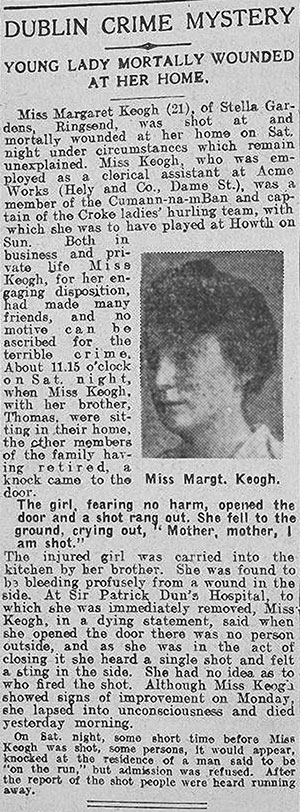
Top: Margaret Keogh, fatally wounded at Stella Gardens, Ringsend, during a series of raids by Crown forces on the eve of the Truce.
Middle: Memorial card of Mary Hartney, the first Cumann na mBan member killed in the Civil War on 4 August 1922 at Adare, Co. Limerick.
Josephine ‘Josie’ McGowan was the first Cumann na mBan member killed during the Irish Revolution. She was from Dolphin’s Barn, Dublin, and had served as a member of the Marrowbone Lane garrison during the 1916 Rising. On 22 September 1918 she attended a Cumann na mBan rally at Foster Place to protest against the internment of republican prisoners. The DMP baton-charged the assembly and during their onslaught a DMP constable struck McGowan several times on the head with his baton. Her comrades rescued her from the assault and took her to their medical outpost in Ticknock. She died there on 29 September 1918 and was buried in Glasnevin Cemetery. Decades later McGowan was posthumously awarded a War of Independence service medal, which included a ‘Comhrac’ bar—an award normally reserved for male combatants.
Margaret Keogh
The second Cumann na mBan member killed was Margaret Keogh, a nineteen-year-old printer’s assistant, who was fatally wounded by a gunshot in her home at Stella Gardens, Ringsend, Dublin, at 11.15pm on 10 July 1921 during a series of raids by Crown forces on the eve of the truce that ended the War of Independence. She died of her wounds two days later. If there was one woman who embodied all of the various strands entwined in the Irish Revolution it was Margaret Keogh. She was the captain of the Croke Ladies Hurling Club, a member of the Irish Clerical Workers Union and an active member of Cumann na mBan. A year prior to her death, she had been arrested by Crown forces for refusing to give her name in English when questioned about her fund-raising activities for Conradh na Gaeilge, which was then a proscribed organisation. She was buried with military honours at Glasnevin Cemetery on 14 July 1921. Her grave is marked by a humble headstone bearing the inscription ‘MARGARET KEOGH—DIED FOR IRELAND’.
During the Truce a further two members of Cumann na mBan were killed. Margaret McAnaney was accidentally shot dead by an IRA Volunteer whilst delivering dispatches at Burnfoot, Co. Donegal, on 31 May 1922. The same day, Margaret McElduff died of an accidental gunshot wound whilst transporting a gun for the IRA in County Tyrone. In the Civil War, whether from political idealism or, more likely, military necessity, women were allowed to play a fuller military role. For example, Elizabeth Maguire acted as a quartermaster for the IRA’s Dublin Brigade and was involved in 28 attacks on Free State troops. Sighle Humphries led an armed Cumann na mBan unit in a raid on a hospital in October 1922 in an attempt to free a wounded IRA Volunteer guarded by Free State soldiers. The following month she was involved in a gun battle with the Free State Army when they captured Ernie O’Malley, the IRA’s assistant chief-of-staff. It is unsurprising, therefore, that Cumann na mBan fatalities doubled during the Civil War.
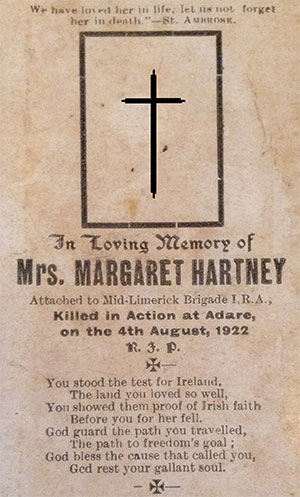
Above: Memorial card of Mary Hartney, the first Cumann na mBan member killed in the Civil War on 4 August 1922 at Adare, Co. Limerick.
Mary Hartney
The first Cumann na mBan member killed in that conflict was Mary Hartney from Limerick City. On 4 August 1922 the Free State Army used artillery to drive the IRA from the town of Adare, Co. Limerick. The Dunraven Arms Hotel, where the republicans had set up their military headquarters, suffered a direct hit during the opening barrage. A short time later a correspondent from the Free State Army’s publicity department reported that ‘all the rooms in the building were found to be bespattered with blood, showing that there must have been fairly severe casualties amongst the irregulars’. In fact only one member of the garrison had been killed—Mary Hartney. She had been working as part of a first aid unit when killed instantly by the shelling. She was buried in the republican plot of Mount St Lawrence Cemetery, Limerick, on 7 August 1922.
Lily Bennett
The next member of Cumann na mBan to be killed by the Free State Army was Lily Bennett from Aughrim Street, Dublin. The Republican Prisoners’ Defence Committee held a public rally each Sunday in O’Connell Street. On 18 November 1922 Lily Bennett was attending the demonstration when Free State troops passing by in a motor convoy attacked the protesters with machine-gun fire from an armoured car. Charlotte Despard, who had been addressing the meeting, later insisted that the Free State Army had opened fire without provocation. Seven people were seriously wounded in the attack, including Lily Bennett, who was shot in the back and died a short time later.
Margaret Dunne
Another member of Cumann na mBan, Margaret Dunne from Cappaleigh South near Castletown in west Cork, was shot dead by the Free State Army six months later. On 8 April 1923 a Free State soldier was wounded during a gunfight with two IRA Volunteers at Adrigole. Approximately ten minutes later the Free State troops spotted Dunne conversing with a third IRA Volunteer who had not been involved in the attack. In an apparent act of reprisal for the wounding of his comrade, Captain Hassett of the Free State Army drew a gun and opened fire on the pair, shooting Margaret Dunne dead. Throughout the Civil War Cumann na mBan had rendered military honours at the funerals of IRA Volunteers killed in action, but for Dunne’s funeral the situation was reversed, as the men of the IRA came out of hiding and risked capture and execution to pay tribute to their fallen female comrade.
Nan Hogan
The final member of Cumann na mBan to die as a result of the conflict appears to have been Annie ‘Nan’ Hogan from Cratloe, Co. Clare. Hogan had organised safe houses during the War of Independence and was leader of the East Clare Brigade of Cumann na mBan. Late in 1922 the republican prisoners in Limerick jail had attempted to escape by digging a tunnel. The plot was betrayed, however, and on the night of the escape attempt Free State soldiers arrested seven Cumann na mBan women outside the prison, including
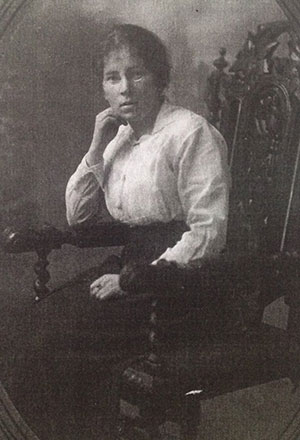
Above: Nan Hogan—her family and friends attributed the 24-year-old’s premature death in September 1923 to her hunger strike in Kilmainham Jail shortly before.
Nan Hogan. She was interned without trial in Kilmainham Jail and went on hunger strike in March 1923 for better conditions and prisoner-of-war status. The hunger strike was eventually called off when it became obvious that the Free State authorities would not concede their demands. Unfortunately, this was too late to save Annie Hogan. She was released in September 1923 and died a short time later. Her family and friends attributed the 24-year-old’s premature death to her hunger strike and the conditions she had suffered in prison.
Forgotten
Surprisingly, the sacrifice of these Cumann na mBan women who died for their cause has been forgotten not only by the Republican Movement but also by historians and academics. Apart from notable exceptions such as Sinéad McCoole’s No ordinary women, which mentions the deaths of Hogan and Dunne, and Mary McAuliffe and Liz Gillis’s We were there—77 women of the Easter Rising, which details the death of McGowan, almost all histories of Cumann na mBan ignore the sacrifice of these women.
Today the men of the Irish Republican Army who fell in the struggle for Irish freedom are honoured by hundreds of monuments nationwide. The boys of Na Fianna Éireann are commemorated by a monument dedicated specifically to them in St Stephen’s Green. But what of the women? There are currently four statues of Constance Markievicz (one in County Sligo and three others in Dublin City), with Dublin City Council reportedly planning a fifth statue of her to mark the centenary of women’s suffrage. There is also an information plaque in Wynn’s Hotel, Dublin, marking it as the place where the inaugural meeting of Cumann na mBan was held in 1914. Nevertheless, as we approach the centenaries of the deaths of Josephine McGowan and her comrades in Cumann na mBan who died for Irish freedom, the question now arises as to why no national memorial has ever been erected commemorating all of the women of Cumann na mBan and the girls of the Clan na nGaedheal Girl Scouts who sacrificed so much for the same cause during the 1916 Rising, the War of Independence and the Civil War.
Pádraig Óg Ó Ruairc is the author of several books on the Irish Revolution of 1913–23.
















